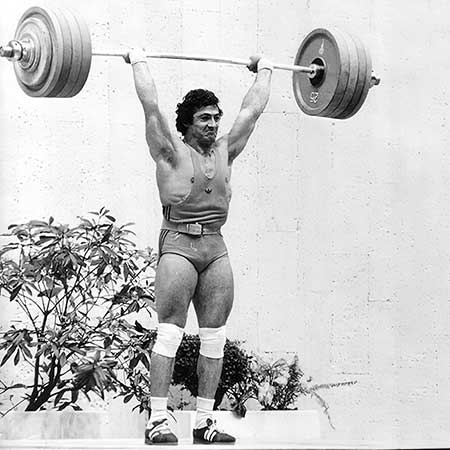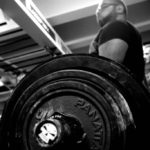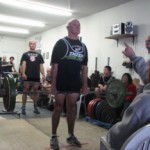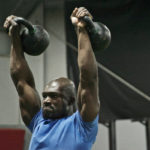Do you remember when you started lifting weights?
I do.
My very first workout was a biceps workout with Chris Read, a senior, and the 140lb starter on the wrestling team, who was built like a mini-Ah-nold, at the base gym (RAF Lakenheath, England). I was a gangly, 15-year-old sophomore.
We did straight bar curls.
Preacher curls.
Alternating dumbbell curls.
And I’m not 100% sure, because this was 1987, over 35 years ago, but I’m pretty sure we finished with concentration curls to hit the “peak.”
Every set was pushed to the limit—maybe a little more.
Lowering the weights e-x-t-r-a… s-l-o-w-l-y… to get the stretch.
I walked away from that workout head held high, a man among boys, I’ll tell you what, yessir!
The next morning was a different story:
I couldn’t move my arms. They were locked in place between slightly bent and 90 degrees.
When I saw Chris at lunch, he laughed hysterically.
I didn’t touch a weight again until April 1989, after I got my left arm out of a cast from breaking it while wrestling.
Then, I was fully “bitten” by the Iron Bug.
I trained at the base gym for the rest of the year and the entire summer, into the fall, while running Cross Country, to get in shape for my senior year of wrestling.
I ran for my heart, lungs, and my legs and did bodybuilding work for my upper body.
The result was a full 15 pounds of muscle—145lbs to 160lbs—between April and August of 1989.
My friends noticed. And the girls turned their heads, including Mara, the super-brainy co-captain of the cheerleading team, with a “Woooowwww!”
Everything a 16-year-old boy/young man dreams of. (Or almost everything.)
It’s these “first impressions” that we carry with us for the rest of our lives, indelibly burned into our brains.
To “get in shape,” you run.
To put on muscle, you work out like Ah-nold, and the rest of the bodybuilders in the 1960s, 70s, 80s, and 90s did.
Body part splits… chest & tris, back & bis, shoulders, legs—maybe, you are running after all…
Multiple exercises per body part:
- Bench
- Incline Bench
- Decline Bench
- Incline Dumbbell Fly’s (or Pullovers)
- Pec Deck (“… for your ‘Inner Chest’ Bro!”)
And every set pushed to failure, or beyond (“C’mon, Bro! One more! One more! It’s all you!”).
Our brains were, and may still be, infected by “Bodybuilding Ideology.”
You know I’m talking about you.
It’s why you still take every set to the max, by compressing your rest periods, even when you “know” you shouldn’t.
It’s why you eke out one more rep even when your technique has tanked, even when you “know” you shouldn’t.
So, let’s dig into what the research says about indulging our “Inner Bodybuilder” and get rid of this infection forever, shall we?
10 Reasons To Avoid Training To Failure (Like A Bodybuilder), Like The Plague
1. Training to failure suppresses your anabolic hormones
Testosterone and IGF-1, which build muscle and burn fat. [1]
2. Training to failure increases the nucleotide, AMP (Adenosine Monophosphate)
Which then signals a decrease in protein synthesis (muscle building). [2] The exact opposite of what we’re looking for.
3. Training to failure increases “central fatigue” [3]—that overall exhausted feeling
Which then decreases performance during your workout along with overall energy levels.
4. Training to failure increases cortisol production [4]
Too much circulating cortisol has been shown to increase stomach fat. [5]
5. Training to failure increases lactic acid (H+) in your bloodstream [6]
Which can lead to increased free radicals, which in turn damage your cell’s “powerhouses”—your mitochondria, making you age faster.
6. Training to failure leads to excessive muscular soreness and muscle damage [7]
Which decreases your insulin sensitivity, which means your body has a tougher time assimilating carbohydrates and increases your chances of storing them as fat.
7. Training to failure increases your chance of injury [8]
Because your technique changes from muscle exhaustion.
8. Training to failure often leads to overtraining [8]
Leaving you feeling always tired, emotionally drained, and physically present but emotionally absent.
9. Training to failure can cause insomnia or interrupted sleep
Which interferes with your body’s ability to recover from your workouts. Plus, lack of sleep increases body fat. [9]
10. Training to failure can deplete your most important muscle fibers
Your fast twitch fibers, from having chronically elevated cortisol levels. [10]
So, if training to failure like a bodybuilder is so bad, what should you do instead?
Since you’re reading this on the StrongFirst website, I’m guessing you know that the first thing you should do is never train to failure.
Instead, train like strength and power athletes:
1. Heavy-ish (for you),
And,
2. Explosively.
Light and middleweight weightlifters are great examples of the physiques most of us would “settle” for.

Use the Following Guidelines
1. Pick 2 to 4 “big” exercises
- Heavy, examples: Press, Squat, Pullup
- Explosive, examples: Clean, Swing, Snatch, Push Press/Jerk
2. Train between 65% and 85% of your maximum lift(s)
And rarely ever to a real max or to failure.
3. Keep your reps low
Between 1 and 3 or 4 to 7.
4. Train 3 days a week
And rest or do mobility/flexibility work on your off days, to help your recovery.
5. Keep your effort levels (Rate of Perceived Exertion—RPE) between a 7 and a 9
And always walk away “fresh” or feeling energized from your practices/ training sessions.
If you commit to training (“working out” in “Inner Bodybuilder” terminology) this way, you will rarely be sore, get incredibly strong, pack on an appreciable amount of muscle in all the right places, and remain relatively lean, assuming you don’t eat like a pig.
Happy Training!

for Men & Women Over 40
to Burn Fat and Build Muscle
in Just 90 Minutes A Week,
without Painful Dieting
To learn more about Easy Muscle e-book, CLICK HERE
References
[1]. https://www.ncbi.nlm.nih.gov/pubmed/16410373
[2]. http://journals.plos.org/plosone/article?id=10.1371/journal.pone.0040621
[3]. https://pubmed.ncbi.nlm.nih.gov/34881412/
[4]. https://journals.physiology.org/doi/full/10.1152/japplphysiol.01400.2005
[5]. https://pubmed.ncbi.nlm.nih.gov/32774535/
[6]. https://pubmed.ncbi.nlm.nih.gov/10023725/
[7]. https://builtwithscience.com/training-to-failure/
[8]. https://www.sciencedaily.com/releases/2022/03/220328165327.htm





What a specious argument against training to failure vs. not training to failure. The first reference sited as a reason to avoid training to failure has nothing to do with the training to failure methodology endorsed by those that employ this process. The methodology outlined in your first paper stated, “During the first 6 wk of training (from T0 to T1), the RF (failure) group trained with three sets of 10RM for the bench press ….” Bodybuilders and other athletes that use PEDs may be able to make progress on such a program, but we mere mortals that do not use drugs will not progress far if we did three sets per body part to failure 2-3 times per week. Those that train to failure recognize that one failure set is the methodology sufficient to achieve desired results, and that three sets to failure will impede progress. Cherry-picking the available data to prove your desired goal/outcome (proving failure is bad) is a disservice and intentionally misleading. I did not read the remaining references presented. If the first reference (https://www.ncbi.nlm.nih.gov/pubmed/16410373) was so inadequate in substantiating your preferred methodology. Sadly, the disingenuous approach fools the less academically inclined, but fools no one that actually reads the paper. Furthermore, there have been many credible papers examining the differences between training to failure and not training to failure. These papers actually reveal little difference in the outcomes when comparing reduced volume one set to failure to higher volume non failure training. Ex: https://physoc.onlinelibrary.wiley.com/doi/10.1113/JP278627. I am not advocating failure over non-failure, or vice versa. I am advocating that the lack of objectivity presented in this paper detracts from instead of supports your position of, “Do not train to failure.’ Such a misleading attempt is dishonest and detracts from the potential benefits of the methodology you endorse.
Hey Geoff, I love your work, particularly anything related to original strength, and agree with most of this. But, number 5 is officially outdated. Anaerobic glycolysis creates lactate not lactic acid. The hydrolysis of ATP is currently considered the most likely culprit for acidity build up when we push the length of anaerobic exercise. Thus, we can say we want to minimize acidity, ie H+ ions, by increasing work to rest ratios, but its inaccurate to say it decreases lactic acid build. The NSCA has a great section about it in their CSCS textbook. There are a couple other articles floating around that clarify this common misconception too.
I love how you say training to failure could induce injury, but you go on to say that one must “train explosively.” Explosive movements are inherently injurious because they are based on sudden contraction of the musculature. Training to failure does not cause injury when performed properly. Training volume is the only factor that can cause overtraining, because the more you do, the more you exhaust. Training to failure limits you to at most a few sets. Training below failure allows you to perform dozens of sets, which is suboptimal and overly fatiguing.
Many, many people, who have been, are, and will be engaged in a wide variety of activities including things as diverse as Olympic weightlifting and kicking a soccer ball, would disagree, and so would I.
I’m not sure how trying but failing to do, well, anything can be considered “proper” but, that aside, the article uses words like “often leads to” and “can cause.” We know people train to failure, and not all of them get hurt, and some succeed. Point granted.
I find fault with your math. It’s easily demonstrated by anyone that one set of 10 reps is more draining (and can therefore lead to many of the problems Geoff mentions) than two sets of 5 reps. One can take as much or as little time between those two sets of 5 as furthers one’s goals, and in short order one can learn to use more weight for the two sets of 5 than for one set of 10 which, with sufficient rest between the sets, will results in more strength or bigger muscles or both – and less fatigue, less degradation of form, and therefore less risk of injury.
Hi Brandon,
Thanks for your comment.
We’ll have to agree to disagree.
And that’s ok. If you enjoy training to failure and it’s producing measurable results for you, then keep doing so.
I’ve trained to failure in the past and gotten injured. Repeatedly.
I’ve trained others, including highly conditioned college athletes using HIT, and they’ve gotten weaker and lost muscle.
All the best to you in your training.
My experience, as a layperson just trying to get fit, is consistent with your view. I used the “Peak 8” version of HIIT: eight sets of 30-second max intensity (9 or 10/10) followed with 90-second active recovery. I did this 20ish-minute workout a few times per week. It was intense and a form of training to failure.
And I got good results for many months. My resting heart rate dropped to around 60, my endurance increased, and I lost waist circumference. But then my recoveries started lengthening, from half a day to one or two days. I compensated by reducing the number of sets, eventually down to four or five. But the recoveries still took days.
Soon I gave it up entirely, realizing dimly that my body was trying to tell me something. I came across HIRT (high-intensity repeat training) and understood why vanilla HIIT is bad, and eventually found kettlebell swings and anti-glycolytic training.
I find this article so contrary to everything published these past several years or longer from professionals like you , such as Jay Vincent, Mike Mentzer, Dorian Yates and the originator of Heavy Duty Training to failure Arthur Jones.
This reminds me of food industry (ie) drink the coffee don’t drink the coffee , drink the coffee! You guys can’t make up your minds on what truly bad or good.
Information overload!
Bob in Parma Ohio
They can train to failure as those dudes are on steroids.
Hey Bob,
I guess it always depends on the goal. There is no „one size fits all“. Professional Bodybuilders have a different approach and goal, than Geoff who focuses on the average Joe and tries him/her the most promising program.
There is a good podcast episode on the Pat Flynn show where Pat Flynn and Dan John talk about that, title „Is training to failure training to fail“ (May 10, 2022). That might help you to understand Geoff’s approach better.
Hi Bob,
Thanks for your comment. I understand things can be confusing.
While it’s true results are produced by both “camps,” I think the “longevity” belongs to not training to failure. If you haven’t given it a shot, I encourage you to do so and see what you think.
At the very least, you’ll at least be able to walk the next day after squatting. 😉
All the best in your training.
Geoff to the point. As always. „No fluff“.
I love(d) the Giant, but I love Easy
Muscle (after a little more than two weeks) even more, because it holds more variety.
Same, same, but different?!?! See for yourself!
Why do I love Easy Muscle? Because it works well with Soccer (my first love): You build resiliance and power endurance on the pitch. It might not be what Geoff intended to create, but it sure as heck does work for that 🙂
Thanks, Christoph.
Glad to hear you like it. Variety is critical for some.
Great to hear it plays nicely with your soccer too. That’s an added, but not surprising bonus since our goal is to mitigate fatigue.
Keep up the great work.
Great article, Geoff! Personally, I’m a fan of Heavy-ish. That’s my sweet spot.
Thank you, Gabby!
That’s a great sweet spot to have.
Second week into Easy Muscle–schedule C.Enjoyable and challenging–i’d recommend it.
Great to hear, Steve.
Please keep us posted with your results.
Great to be reminded of these principles. Always trained this way now for years. Its awesome for sure.
In my case (long, lanky, skinny ectomorph body type) I needed to add higher reps 10-12 for 24kg MP to solidify my 1/2 bw (36press) that I can easily do now despite rarely doing MPs – I do more dips and pushups now.
Also have been adding some sets to near failure and getting some burn on purpose to hopefully stimulate hypertrophy and tendon strength.
As far as AMP, Q&D talks about purposeful AMP production to help stimulate mitochondrial growth (size and number).
Stay Strong!
Glad to hear, Brent.
“Near failure,” like 1-3 reps “in the bank” works too when used sparingly.
Keep up the great work.